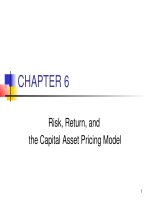Lecture biology (6e) chapter 6 campbell, reece
Bạn đang xem bản rút gọn của tài liệu. Xem và tải ngay bản đầy đủ của tài liệu tại đây (274.21 KB, 34 trang )
CHAPTER 6 AN INTRODUCTION TO
METABOLISM
Section A: Metabolism, Energy, and Life
1. The chemistry of life is organized into metabolic pathways
2. Organisms transform energy
3. The energy transformations of life are subject to two laws of
thermodynamics
4. Organisms live at the expense of free energy
5. ATP powers cellular work by coupling exergonic reactions to endergonic
reactions
Copyright © 2002 Pearson Education, Inc., publishing as Benjamin Cummings
1. The chemistry of life is organized into
metabolic pathways
• The totality of an organism’s chemical reactions is
called metabolism.
• A cell’s metabolism is an elaborate road map of the
chemical reactions in that cell.
• Metabolic pathways alter molecules in a series of
steps.
Copyright © 2002 Pearson Education, Inc., publishing as Benjamin Cummings
Fig. 6.1 The inset shows
the first two steps in the
catabolic pathway that
breaks down glucose.
Copyright © 2002 Pearson Education, Inc., publishing as Benjamin Cummings
• Enzymes selectively accelerate each step.
• The activity of enzymes is regulated to maintain an
appropriate balance of supply and demand.
• Catabolic pathways release energy by breaking
down complex molecules to simpler compounds.
• This energy is stored in organic molecules until it needs
to do work in the cell.
• Anabolic pathways consume energy to build
complicated molecules from simpler compounds.
• The energy released by catabolic pathways is used
to drive anabolic pathways.
Copyright © 2002 Pearson Education, Inc., publishing as Benjamin Cummings
• Energy is fundamental to all metabolic processes,
and therefore to understanding how the living cell
works.
• The principles that govern energy resources in
chemistry, physics, and engineering also apply to
bioenergetics, the study of how organisms manage
their energy resources.
Copyright © 2002 Pearson Education, Inc., publishing as Benjamin Cummings
2. Organisms transform energy
• Energy is the capacity to do work - to move matter
against opposing forces.
• Energy is also used to rearrange matter.
• Kinetic energy is the energy of motion.
• Objects in motion, photons, and heat are examples.
• Potential energy is the energy that matter possesses
because of its location or structure.
• Chemical energy is a form of potential energy in
molecules because of the arrangement of atoms.
Copyright © 2002 Pearson Education, Inc., publishing as Benjamin Cummings
• Energy can be converted from one form to another.
• As the boy climbs the ladder to the top of the slide he
is converting his kinetic energy to potential energy.
• As he slides down, the
potential energy is
converted back to
kinetic energy.
• It was the potential energy
in the food he had eaten
earlier that provided the
energy that permitted him
to climb up initially.
Fig. 6.2
Copyright © 2002 Pearson Education, Inc., publishing as Benjamin Cummings
• Cellular respiration and other catabolic pathways
unleash energy stored in sugar and other complex
molecules.
• This energy is available for cellular work.
• The chemical energy stored on these organic
molecules was derived primarily from light energy
by plants during photosynthesis.
• A central property of living organisms is the ability
to transform energy.
Copyright © 2002 Pearson Education, Inc., publishing as Benjamin Cummings
3. The energy transformations of life are
subject to two laws of thermodynamics
• Thermodynamics is the study of energy
transformations.
• In this field, the term system indicates the matter
under study and the surroundings are everything
outside the system.
• A closed system, like liquid in a thermos, is isolated
from its surroundings.
• In an open system energy (and often matter) can be
transferred between the system and surroundings.
Copyright © 2002 Pearson Education, Inc., publishing as Benjamin Cummings
• Organisms are open systems.
• They absorb energy - light or chemical energy in organic
molecules - and release heat and metabolic waste
products.
• The first law of thermodynamics states that
energy can be transferred and transformed, but it
cannot be created or destroyed.
• Plants transform light to chemical energy; they do not
produce energy.
Copyright © 2002 Pearson Education, Inc., publishing as Benjamin Cummings
• The second law of thermodynamics states that
every energy transformation must make the
universe more disordered.
• Entropy is a quantity used as a measure of disorder, or
randomness.
• The more random a collection of matter, the greater its
entropy.
• While order can increase locally, there is an unstoppable
trend toward randomization of the universe.
• Much of the increased entropy of the universe takes the
form of increasing heat which is the energy of random
molecular motion.
Copyright © 2002 Pearson Education, Inc., publishing as Benjamin Cummings
• In most energy transformations, ordered forms of
energy are converted at least partly to heat.
• Automobiles convert only 25% of the energy in gasoline
into motion; the rest is lost as heat.
• Living cells unavoidably convert organized forms of
energy to heat.
• The metabolic breakdown of food ultimately is released
as heat even if some of it is diverted temporarily to
perform work for the organism.
• Heat is energy in its most random state.
• Combining the two laws, the quantity of energy is
constant, but the quality is not.
Copyright © 2002 Pearson Education, Inc., publishing as Benjamin Cummings
• Living organisms, ordered structures of matter, do
not violate the second law of thermodynamics.
• Organisms are open systems and take in organized
energy like light or organic molecules and replace
them with less ordered forms, especially heat.
• An increase in complexity, whether of an organism
as it develops or through the evolution of more
complex organisms, is also consistent with the
second law as long as the total entropy of the
universe, the system and its surroundings, increases.
• Organisms are islands of low entropy in an increasingly
random universe.
Copyright © 2002 Pearson Education, Inc., publishing as Benjamin Cummings
4. Organisms live at the expense of free
energy
• Spontaneous processes are those that can occur
without outside help.
• The processes can be harnessed to perform work.
• Nonspontaneous processes are those that can only
occur if energy is added to a system.
• Spontaneous processes increase the stability of a
system and nonspontaneous processes decrease
stability.
Copyright © 2002 Pearson Education, Inc., publishing as Benjamin Cummings
• The concept of free energy provides a criterion for
measuring spontaneity of a system.
• Free energy is the portions of a system’s energy
that is able to perform work when temperature is
uniform throughout the system.
Fig. 6.5
Copyright © 2002 Pearson Education, Inc., publishing as Benjamin Cummings
• The free energy (G) in a system is related to the
total energy (H) and its entropy (S) by this
relationship:
• G = H - TS, where T is temperature in Kelvin units.
• Increases in temperature amplify the entropy term.
• Not all the energy in a system is available for work
because the entropy component must be subtracted from
the maximum capacity.
• What remains is free energy.
Copyright © 2002 Pearson Education, Inc., publishing as Benjamin Cummings
• Free energy can be thought of as a measure of the
stability of a system.
• Systems that are high in free energy - compressed
springs, separated charges - are unstable and tend to
move toward a more stable state, one with less free
energy.
• Systems that tend to change spontaneously are those that
have high energy, low entropy, or both.
• In any spontaneous process, the free energy of a
system decreases.
Copyright © 2002 Pearson Education, Inc., publishing as Benjamin Cummings
• We can represent this change in free energy from the
start of a process until its finish by:
• delta G = G final state - G starting state
• Or delta G = delta H - T delta S
• For a system to be spontaneous, the system must
either give up energy (decrease in H), give up order
(decrease in S), or both.
• Delta G must be negative.
• The greater the decrease in free energy, the greater the
maximum amount of work that a spontaneous process can
perform.
ã Nature runs downhill.
Copyright â 2002 Pearson Education, Inc., publishing as Benjamin Cummings
• A system at equilibrium is at maximum stability.
• In a chemical reaction at equilibrium, the rate of forward
and backward reactions are equal and there is no change
in the concentration of products or reactants.
• At equilibrium delta G = 0 and the system can do no
work.
• Movements away from equilibrium are
nonspontaneous and require the addition of energy
from an outside energy source (the surroundings).
Copyright © 2002 Pearson Education, Inc., publishing as Benjamin Cummings
• Chemical reactions can be classified as either
exergonic or endergonic based on free energy.
• An exergonic reaction proceeds with a net release
of free energy and delta G is negative.
Fig. 6.6a
Copyright © 2002 Pearson Education, Inc., publishing as Benjamin Cummings
• The magnitude of delta G for an exergonic reaction is the maximum amount of work the reaction can perform.
• For the overall reaction of cellular respiration:
• C6H12O6 + 6O2 -> 6CO2 + 6H2O
• delta G = -686 kcal/mol
• Through this reaction 686 kcal have been made available to do work in the cell.
• The products have 686 kcal less energy than the reactants.
Copyright © 2002 Pearson Education, Inc., publishing as Benjamin Cummings
• An endergonic reaction is one that absorbs free
energy from its surroundings.
• Endergonic reactions store energy,
• delta G is positive, and
ã reactions are
nonspontaneous.
Fig. 6.6b
Copyright â 2002 Pearson Education, Inc., publishing as Benjamin Cummings
• If cellular respiration releases 686 kcal, then
photosynthesis, the reverse reaction, must require an
equivalent investment of energy.
• Delta G = + 686 kcal / mol.
• Photosynthesis is steeply endergonic, powered by
the absorption of light energy.
Copyright © 2002 Pearson Education, Inc., publishing as Benjamin Cummings
• Reactions in closed systems eventually reach
equilibrium and can do no work.
• A cell that has reached metabolic equilibrium has a
delta G = 0 and is dead!
• Metabolic disequilibrium is one of the defining
features of life.
Fig. 6.7a
Copyright © 2002 Pearson Education, Inc., publishing as Benjamin Cummings
• Cells maintain disequilibrium because they are
open with a constant flow of material in and out of
the cell.
• A cell continues to do work throughout its life.
Fig. 6.7b
Copyright © 2002 Pearson Education, Inc., publishing as Benjamin Cummings









